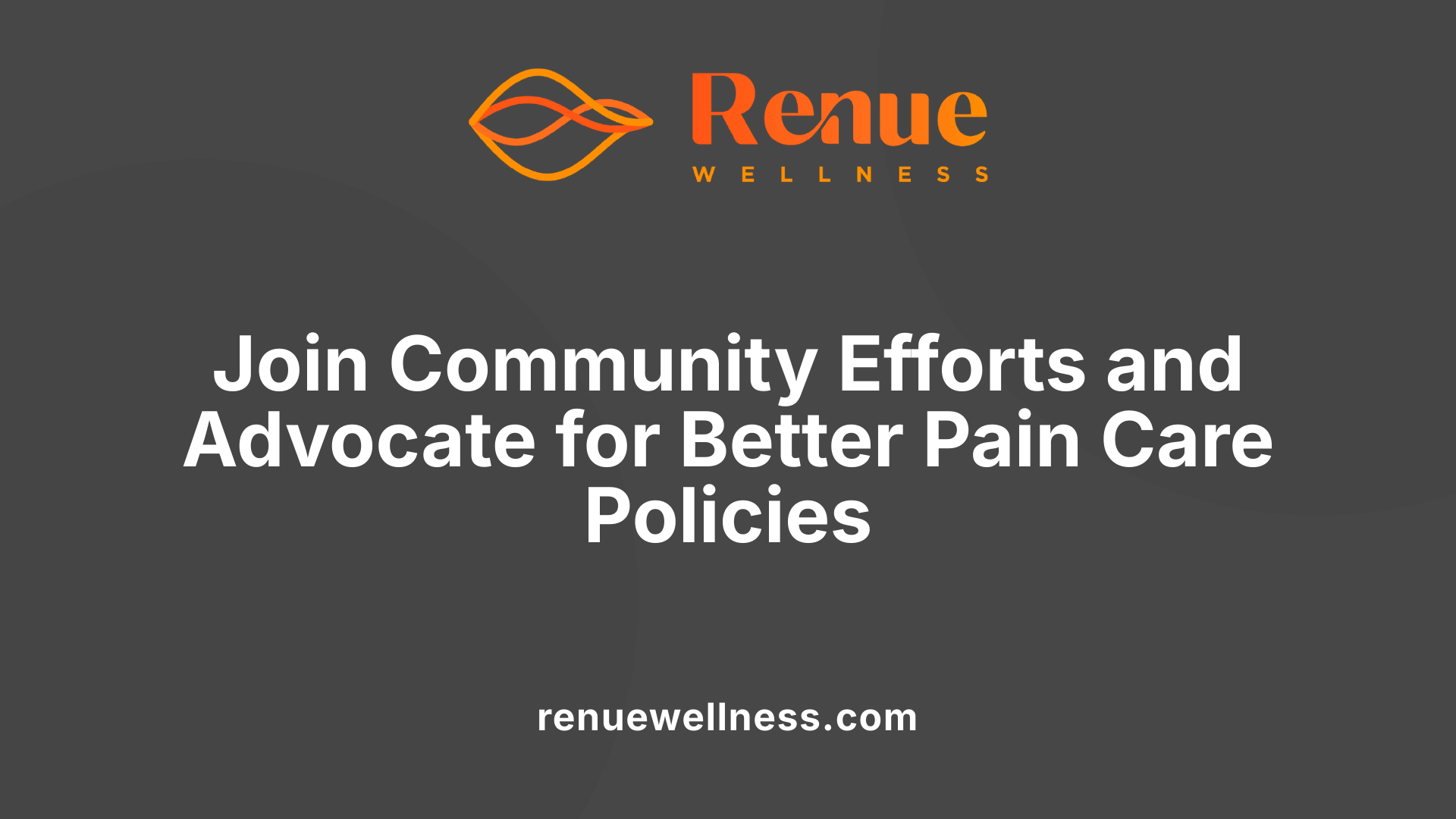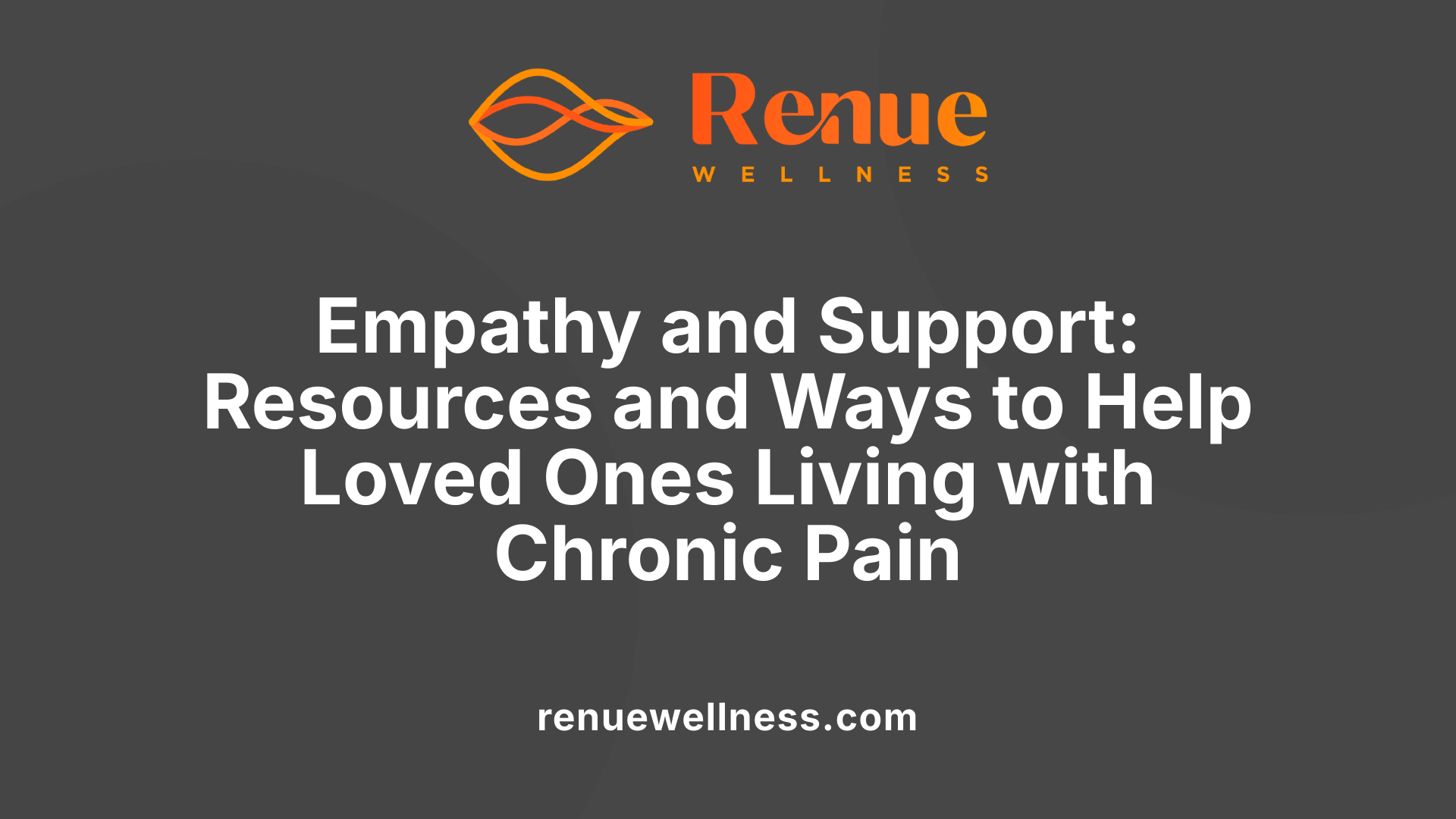Pain Awareness Month: Chronic Pain Solutions You May Not Know About


August 4, 2025
Raising Awareness and Exploring Innovative Solutions
September marks Pain Awareness Month, a vital campaign to shed light on the often invisible and misunderstood condition of chronic pain. With millions affected across the globe and significant advancements in research and management strategies, this month serves as an opportunity to educate, advocate, and empower those living with pain. In this article, we delve into common misconceptions, groundbreaking research efforts, holistic management approaches, and ways the community can support chronic pain sufferers.
The Nature and Impact of Chronic Pain

What are common myths and misconceptions about chronic pain?
Many myths and misconceptions surround chronic pain, often leading to misunderstanding and inadequate treatment. One prevalent falsehood is that pain always signifies tissue damage or harm. However, in many chronic pain conditions, pain can persist even when no clear signs of injury or damage are present, often due to abnormal signaling in the brain and nervous system. This can make patients believe they are not truly injured when, in reality, their pain is real and significant.
Another misconception is that if tests such as X-rays or MRIs show no damage, the pain must be imaginary or psychosomatic. This is not true; pain is processed by the brain and can exist without detectable tissue abnormality. Many people assume that managing chronic pain relies solely on medications, but effective treatment often involves active strategies like physical therapy, psychological support, and lifestyle adjustments. Some also believe that pain always worsens with age or that patients should remain in bed, but staying active within limits can improve function and diminish pain; understanding that pain can be managed and sometimes alleviated is vital.
What are the most effective management and treatment options for chronic pain?
Managing chronic pain effectively requires a comprehensive, multimodal approach tailored to each individual. Lifestyle modifications play a crucial role; these include maintaining a healthy weight, managing stress through relaxation techniques, and engaging in regular physical activity to strengthen muscles and improve mobility.
In terms of medical treatments, nonsteroidal anti-inflammatory drugs (NSAIDs), antidepressants, anti-seizure medications, and, when appropriate, opioids are used to control pain. However, medications are often combined with physical and occupational therapy, massage, and minimally invasive procedures like nerve blocks or injections to target pain specifically.
Psychological therapies are equally important. Cognitive-behavioral therapy (CBT), acceptance and commitment therapy (ACT), and mindfulness-based approaches help patients develop coping strategies, reduce emotional distress, and improve their perception of pain.
Additionally, surgical interventions or newer procedures like neurostimulation are options for certain conditions. Ongoing support from healthcare providers, regular evaluation of treatment effectiveness, and patient education are key to maintaining quality of life. Combining these strategies allows for personalized treatment plans that address both the physical and emotional aspects of chronic pain, leading to better outcomes.
Current Research and Future Directions in Pain Management

NIH-funded pain research initiatives
The National Institutes of Health (NIH) supports an extensive portfolio of pain research through collaborations like the NIH Pain Consortium and the HEAL Initiative. These programs focus on uncovering new cellular targets affecting pain, discovering molecules that could serve as alternatives to opioids, and developing innovative therapeutics. Such efforts aim to expand understanding and treatment options for chronic pain, ultimately reducing the reliance on opioid-based therapies.
Emerging therapies and non-opioid treatments
Researchers are actively exploring new treatments that prioritize safety and effectiveness without the risks associated with opioids. Advances include the development of non-opioid medications, such as anti-inflammatory agents, nerve growth inhibitors, and biologics. Additionally, integrative approaches like meditation, heat therapy, and cannabis are gaining prominence as complementary strategies to relieve pain and improve quality of life.
Technological advancements in understanding pain mechanisms
Modern technologies, including neuroimaging techniques like functional MRI, are transforming pain research. These tools allow scientists to visualize brain activity related to pain perception, such as the role of the orbitofrontal cortex in chronic pain. Such insights deepen our understanding of pain pathways and can lead to more targeted therapies.
Role of personalized medicine and biomarkers
The future of pain management lies in individualized treatment plans tailored to each patient’s unique biological profile. Research into biomarkers—molecular or genetic indicators of pain susceptibility and response—aims to facilitate more precise diagnoses and effective interventions. By identifying early predictors of chronic pain, clinicians can implement early, personalized strategies to prevent or mitigate persistent pain conditions.
| Research Focus | Advances | Impact |
|---|---|---|
| Cellular targets | New molecules for drug development | Safer, more effective pain meds |
| Neuroimaging | Visualizing pain pathways | Better understanding of pain mechanisms |
| Biomarkers | Predictors for pain development | Personalized treatment plans |
| Non-opioid drugs | Alternative therapies | Reduced dependency and side effects |
Holistic and Innovative Approaches to Pain Relief
 Pain management is evolving beyond traditional medications to include a variety of multidisciplinary, complementary, and community-based strategies. Key to this approach is the assembly of specialized pain management teams, comprised of physicians, physical therapists, psychologists, and other healthcare professionals. These teams work together to develop personalized treatment plans that incorporate pharmacological and non-pharmacological therapies, promoting a more comprehensive approach to pain relief.
Pain management is evolving beyond traditional medications to include a variety of multidisciplinary, complementary, and community-based strategies. Key to this approach is the assembly of specialized pain management teams, comprised of physicians, physical therapists, psychologists, and other healthcare professionals. These teams work together to develop personalized treatment plans that incorporate pharmacological and non-pharmacological therapies, promoting a more comprehensive approach to pain relief.
Complementary therapies such as meditation, heat therapy, and herbal treatments are gaining recognition for their ability to reduce pain and improve mental health. Meditation and mindfulness practices help patients manage stress and emotional distress associated with chronic pain, while heat therapy can alleviate muscle tension and improve blood flow. Certain herbal treatments and alternative interventions like acupuncture are also becoming more mainstream, often used alongside conventional medicine to enhance overall effectiveness.
An essential component of successful pain management is patient education and self-management. Educating patients about their condition, the nature of chronic pain, and available treatment options empowers them to participate actively in their recovery. Strategies such as keeping a pain diary, setting realistic goals, and adopting lifestyle modifications like regular exercise, healthy diet, and stress reduction techniques contribute to better outcomes. Patients who are well-informed are more likely to adhere to treatment plans, recognize signs of exacerbation, and communicate effectively with healthcare providers.
During Pain Awareness Month, community engagement and advocacy efforts play vital roles. Organizations such as the American Chronic Pain Association and local clinics organize webinars, awareness campaigns, and support groups to connect individuals suffering from pain. These activities foster a sense of community, combat stigma, and highlight the importance of research and policy changes to improve pain care.
Understanding the different frameworks for managing chronic pain can enhance the effectiveness of treatments. For example, the 4 P's—Pain, Purpose, Pacing, and Positivity—provide a holistic view that emphasizes not just symptom control but also improving quality of life through meaningful activity and mental resilience. Similarly, the 4 A's—analgesia, activities of daily living, adverse events, and aberrant drug-taking behaviors—help clinicians monitor treatment safety and efficacy, balancing pain relief with minimizing risks.
Collectively, these approaches underscore the importance of integrating medical expertise, patient involvement, and community support to advance pain relief strategies in 2024 and beyond.
Community and Policy Initiatives Supporting Chronic Pain Patients

Role of organizations like the American Chronic Pain Association and NIH
Organizations such as the American Chronic Pain Association (ACPA) and the National Institutes of Health (NIH) play vital roles in supporting individuals living with chronic pain. The ACPA, established in 1980, actively raises awareness during Pain Awareness Month in September and advocates for better access to treatment and patient support. It provides educational resources, support groups, and advocacy tools to empower patients.
The NIH supports a broad research portfolio to understand pain better and develop effective treatments. Initiatives like the NIH Pain Consortium and the HEAL (Helping to End Addiction Long-term) Initiative facilitate collaborative research efforts. They focus on uncovering new cellular targets, developing non-opioid therapies, and involving patients in research prioritization to improve outcomes.
Community events and educational webinars
During Pain Awareness Month, various organizations host community events and online webinars aimed at educating the public, healthcare providers, and policymakers. These events cover topics like pain management strategies, mental health, and the latest research advances. For instance, webinars on Medical Cannabis & CBD for Juvenile Spondyloarthritis and discussions with medical professionals help dispel myths and promote informed decision-making.
Educational videos and infographics offered during these events highlight the psychosocial impact of pain and emphasize holistic treatment approaches. Community involvement encourages peer support, fosters understanding, and promotes self-management skills among those affected.
Importance of destigmatizing chronic pain
Despite the widespread impact, chronic pain remains an invisible condition, often leading to misunderstanding and stigma. Many patients report feeling dismissed or misunderstood by healthcare providers and loved ones. Efforts during Pain Awareness Month aim to destigmatize chronic pain, emphasizing it as a genuine medical issue rather than a sign of weakness.
By sharing personal stories, increasing public knowledge, and advocating for respectful care, communities help create a more empathetic environment. This cultural shift encourages patients to seek help without fear of judgment and promotes more compassionate healthcare practices.
Advocacy efforts and policy changes
Advocacy at the policy level is crucial for improving pain management services and research funding. Organizations collaborate with policymakers to promote laws that enhance access to multidisciplinary treatments, support pain research, and address barriers like high medication costs. The American Chronic Pain Association and other groups actively participate in campaigns to influence healthcare policies.
Increased awareness can lead to better insurance coverage for comprehensive pain management, including alternative therapies. It also encourages funding for innovative research to discover new treatments and improve patient outcomes. These collective efforts aim to ensure that chronic pain sufferers receive the care, respect, and understanding they deserve.
Below is a summary table outlining the main community and policy initiatives:
| Initiative Type | Description | Impact |
|---|---|---|
| Organizational Support | Role of ACPA and NIH in education and research | Empowers patients, advances scientific understanding |
| Community Engagement | Hosting webinars, local events, support groups | Fosters peer support, increases awareness |
| Anti-Stigma Campaigns | Public stories, awareness drives | Reduces misunderstanding and discrimination |
| Policy Advocacy | Engaging lawmakers, promoting legislation | Improves access to treatment, research funding |
Through these combined efforts, communities and policymakers work together to improve the lives of those affected by chronic pain, ensuring their needs are recognized and addressed effectively.
Supporting Those Living with Chronic Pain and Their Families

What are common myths and misconceptions about chronic pain?
Many misconceptions exist around chronic pain that can hinder proper understanding and support for sufferers.
A prevalent myth is that pain always indicates ongoing tissue damage or harm. However, in many chronic pain conditions, the pain persists without any actual injury, often due to abnormal signaling in the brain and nervous system.
Another false belief is that if medical tests reveal no damage, the pain must be “in the mind” or imaginary. In reality, pain is a complex experience processed by the brain, and its existence is genuine even when tests do not show physical damage.
Some assume managing chronic pain relies solely on medications, but active approaches like physical therapy, mental health support, and lifestyle modifications can be equally or more effective.
Lastly, there's a misconception that pain naturally worsens with age or that patients should simply rest and avoid activity. Evidence suggests that staying active and addressing underlying conditions often helps to improve the quality of life for those with chronic pain.
Ways to support affected individuals
Supporting someone with chronic pain involves empathy, patience, and education. Listening without judgment and encouraging open dialogue can help sufferers feel understood.
Providing practical assistance, such as helping with daily tasks or accompanying them to medical appointments, can make a significant difference.
Encouraging healthy lifestyle changes like gentle exercise, balanced nutrition, and stress management supports their overall well-being.
Importance of empathy, patience, and education
Empathy and patience are vital, as chronic pain is often invisible and misunderstood. Educating oneself about the condition can foster compassion and reduce stigma.
Understanding that pain is a complex, real condition helps dispel misconceptions and promotes supportive attitudes.
Resources for caregivers and loved ones
Numerous resources are available to help caregivers, including online support groups, educational materials on pain management, and counseling services. Organizations such as the American Chronic Pain Association and local pain clinics offer valuable guidance.
Supporting a loved one through chronic pain can be emotionally taxing. Self-care for caregivers is essential to maintain their own health and resilience.
How individuals can participate in Pain Awareness Month
During Pain Awareness Month in September, individuals are encouraged to advocate for better understanding and support for pain sufferers.
Participation options include sharing personal stories on social media, donating time or money to organizations, organizing or attending awareness events, and supporting policies that improve pain management and research funding.
By increasing awareness and promoting empathy, everyone can help reduce stigma and improve quality of life for those affected by chronic pain.
Moving Forward with Awareness and Compassion
As we observe Pain Awareness Month, it is crucial to recognize the complexity of chronic pain and the multifaceted approaches available to manage it. From groundbreaking research and innovative treatments to community engagement and compassionate care, there is hope for improved quality of life for millions. Educating oneself, dispelling myths, and advocating for better policies are essential steps in creating a supportive environment. Together, through ongoing awareness and collective effort, we can advance understanding, reduce stigma, and foster a future where effective pain management is accessible for all.
References
- Pain Awareness Month
- September is Pain Awareness Month: We Are All in This Together
- Pain Awareness Month 2024 - U.S. Pain Foundation
- September Is Pain Awareness Month - Arthritis Foundation
- Pain Awareness Month: Understanding, Treating, and Observing
- Pain Awareness Month: Chronic Pain Relief Options
- September is Pain Awareness Month! - Caldwell Medical Center
Recent Posts
Conditions Treated
AnxietyDepressionOCDPTSDPostpartum DepressionPain ManagementSubstance AbuseSuicidal IdeationOur Location


